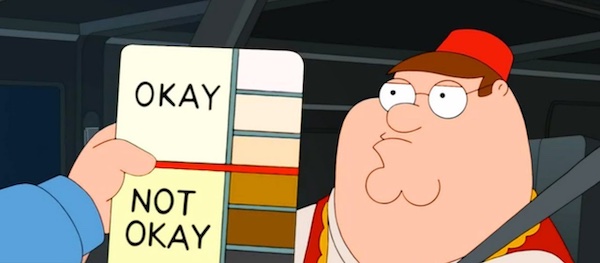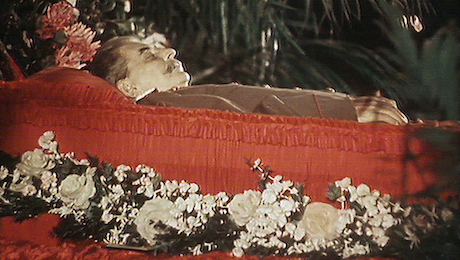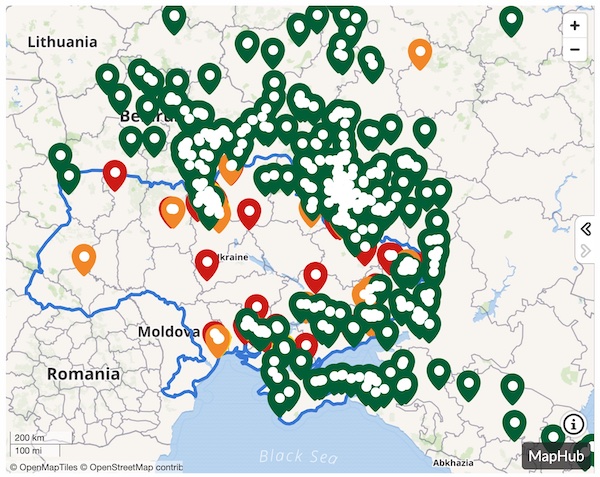A moment of brightness in a dark time.
Thanks to Tony Pierce for the find!
A moment of brightness in a dark time.
Thanks to Tony Pierce for the find!

The reportage of the Ukrainian refugee crisis has unearthed some ugly truths that are worth discussing.
Here’s CBS News’ Charlie D’Agata reporting from Ukraine at the start of the Russian invasion:
Here’s how he described Ukraine:
“…a place, with all due respect, like Iraq or Afghanistan, that has seen conflict raging for decades. This is a relatively civilized, relatively European – I have to choose those words carefully, too – city, one where you wouldn’t expect that, or hope that it’s going to happen.”
It’s been said before, but it’s worth repeating: What the hell would he have said if he wasn’t choosing his words carefully?
You don’t really need to wonder, as NBC News’ Kelly Cobiella eagerly said the quiet part out loud:
Here’s what she said:
“…just to put it bluntly, these are not refugees from Syria; these are refugees from neighboring Ukraine. Quite frankly, it is part of it. These are Christians, they’re white, they’re very similar to people who live in Poland [where she was reporting from]…”
She’s not even falling back on the weasel-word phrase “Judeo-Christian” — just Christian. She doesn’t sound all that different from Republican candidate Lauren Witzke, who identifies with the Christian values of Ukraine’s neighbor’s leader:
Here’s Lauren Witzke, the GOP’s 2020 Senate candidate in Delaware, heaping praise on Putin for taking care of his people.
“I identify more with Putin’s Christian values than I do with Joe Biden.” pic.twitter.com/6ldCD2vukm
— Ed Greenberger (@EdGreenberger) February 24, 2022
And if you think that she showed a certain ugly bias, you ain’t seen nuthin’ yet. Here’s Ukrainian politician David Sakvarelidze on the crisis:
In the interview, he called the current crisis very emotional because it involves…
“…European people with blue eyes and blonde hair being killed…”
The idea of Europe as a continent is a social construction, not a geophysical reality. Just so you know.
This hasn’t gone unnoticed by the folks at Gravitas, a news show presented by WION, a New Delhi-based English language news channel whose name is short for “World Is One Network”:
Rebel HQ (part of TYT) has these observations:
One of my favorite journalists, Medhi Hasan, had a conversation with Ayman Mohyeldin about this matter:
This is a civilized city!
They’re blue-eyed and blond-haired!
This is Europe, not the Third World!Tonight on @MSNBC, @AymanM and I discussed some of the awful and, frankly, racist coverage of the Ukraine war & Ukrainian refugees compared to the MidEast:pic.twitter.com/ir6qWHBNE6
— Mehdi Hasan (@mehdirhasan) February 28, 2022
…and let’s not forget The Daily Show, whose host Trevor Noah grew up in South Africa and knows a thing or two about how some people see that more melanin means less value as a human being:
First Coast News have also noticed the difference in treatment when the refugees are white:
Because there’s always someone who will counter these observations with the rebuttal that this is not the time to bring up this discussions as there are Ukrainians who may no longer have homes.
I will respond by borrowing a line from the soldiers on Ukraine’s Snake Island…
Privileged person: Go fuck yourself.
We can chew gum and walk at the same time. It is possible to stand with displaced people from Ukraine and stand with displaced people who aren’t blonde-haired and blue-eyed.
The fact that you can’t treat these groups with the same level of dignity speaks volumes.

In a recent tweet, Odile Turcu reminded us that “Generally speaking, March is a bad month for Russian leaders”. She backed up her point with these names, which I’ve expanded upon:
Once again: Happy Stalin’s Death Day!

The Russia-Ukraine Monitor Map is a public resource for mapping, documenting, and verifying significant incidents that happen in the Russian invasion of Ukraine. Its goal, as stated on its webpage, is to “provide reliable information for policymakers, journalists as well as justice and accountability bodies about the evolving situations both on-the-ground and online.”
Created by Centre for Information Resilience and contributed to by Bellingcat, Mnemonic, Conflict Intelligence Team, and other members of the open source intelligence (OSINT) community, the purpose of the map is to provide reliable information. Its content is logged in a central database whose contents will be archived for future use by researchers, reporters as well as justice and accountability bodies.
Incidents or events are indicated on the map with colored “pin” icons. Each has been verified via image — photo, video, or satellite imagery — to confirm where and when it took place.
 Green map pins indicate the movement and buildup of military assets. You’ll see many of these outside Ukraine, as they’re often visuals of supply convoys or trains bringing weaponry or soldiers.
Green map pins indicate the movement and buildup of military assets. You’ll see many of these outside Ukraine, as they’re often visuals of supply convoys or trains bringing weaponry or soldiers.
 Yellow map pins indicate “other footage” that don’t fit any of the other pin categories.
Yellow map pins indicate “other footage” that don’t fit any of the other pin categories.
 Orange map pins indicate evidence of gunfire, bombing, shelling, or explosion, but not necessarily civilian casualties, infrastructure damage, or military losses.
Orange map pins indicate evidence of gunfire, bombing, shelling, or explosion, but not necessarily civilian casualties, infrastructure damage, or military losses.
 Red map pins indicate civilian casualties, infrastructure damage and military losses.
Red map pins indicate civilian casualties, infrastructure damage and military losses.
Click on a map pin to get more details about the incident at its location:
Another way to view incidents on the map is to use the list on the right side:
For more about the Russia-Ukraine Monitor Map, see Bellingcat’s article, Follow the Russia-Ukraine Monitor Map, as well as this CBC (Canadian Broadcasting Corporation, Canada’s national public broadcaster) report:

Someone at FLDOT (Florida Department of Transportation) forgot the old “30 days in September…” rhyme.
[ Photo by Mel Hall; found via Florida Memes. The building just past the “Exit 11A” sign is has a Gai Consultants sign on it, so this photo must have been taken a little bit east of there. ]